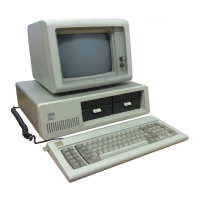The memory
is
dynamic 16K x 1 chips with an access time
of
250 ns
and a cycle time
of
410 ns. All
R/W
memory is parity checked.
The System Board contains circuits for attaching an audio cassette,
the serial keyboard, and the speaker. The cassette adapter allows the
attachment
of
any good quality audio cassette via either the microphone
1"""""\
or
auxiliary inputs. The board has a jumper for either input. This
interface also provides a cassette motor control line for transport
starting and stopping under program control. This interface reads and
writes the audio cassette at a data rate
of
between 1,000 and 2,000
baud. The baud rate is variable and dependent on data content since a
different bit-cell time is used for
O's
and 1
'so
For
diagnostic purposes,
the tape interface can loop read to write to test the board's circuits.
The system software blocks cassette data, generates and checks data
with a Cyclic Redundancy Check (CRC).
The processor also contains the adapter circuits
for
attaching the
serial interface from the keyboard. This generates an interrupt to the
processor when a complete scan code
is
received. This interface can
request execution
of
a diagnostic in the keyboard.
Both the keyboard and cassette interfaces are provided via 5-pin
DIN
connectors, which are right angle mounts on the System Board
and extend through the rear panel
of
the System Unit.
.~
The system is provided with a 2-1/4-inch audio speaker mounted inside
the System Unit. The System Board contains the control circuits and
driver for the speaker. The speaker connects through
a 2-wire interface
which attaches to a 4-pin header on the System Board.
The speaker drive circuit is capable
of
approximately a
1/2
watt
of
power. The control circuits allow the speaker to be driven several
different ways. First, a direct program control register bit may be
toggled to generate a pulse train; second, the output
of
Channel 2
of
the
timer counter may be programmed to generate a waveform to the
speaker. Third, the clock input to the timer/counter can be modulated
with a program controlled
I/O Register Bit. All three forms
of
control
may be performed simultaneously.
2-5

